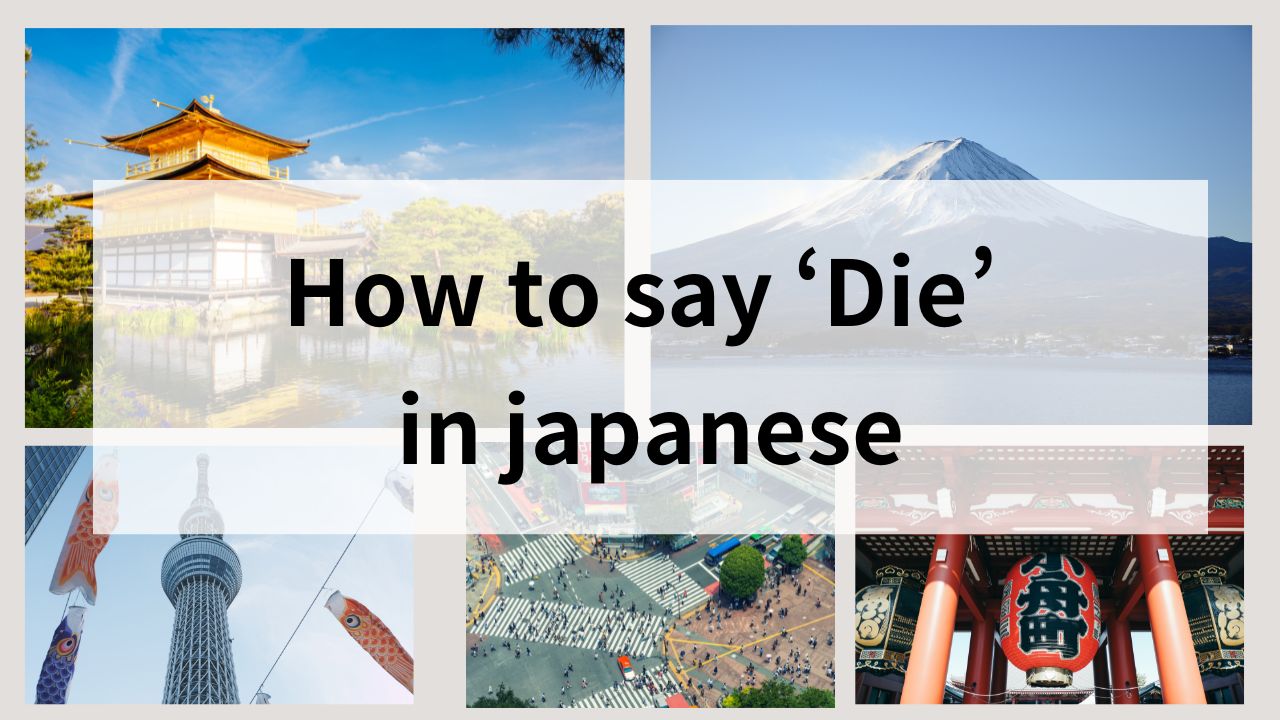Are you curious about how to say “die” in Japanese? The concept of dying carries various cultural meanings and associations in Japan, from the literal act of death to metaphorical uses in language. This guide will explore the Japanese word for “die,” its cultural significance, and practical applications.
How Do You Say “Die” in Japanese?
The Japanese word for “die” is 死ぬ (shinu). This term is commonly used in both casual and formal contexts to refer to the act of dying. The concept of death in Japan is often treated with a combination of respect and somberness, reflecting the culture’s deep-rooted traditions and beliefs surrounding life and death.
The Japanese Word for Die: Shinu (死ぬ)
“Shinu” is a verb used to describe the action of dying and can be found in various phrases and contexts. For example:
- 彼は死んだ (Kare wa shinda): “He has died.”
- 死にたくない (Shinitakunai): “I don’t want to die.”
- 死の恐れ (Shi no osore): “Fear of death.”
Kanji for Die: 死
The kanji for die, 死, is often used in literature, traditional contexts, and everyday language. This character embodies the concept of death, and its primary reading is し (shi), which is commonly used in compound words related to death.
Examples of words containing the kanji 死 include:
- 死亡 (Shibou): “Death,” often used in official or medical contexts.
- 死体 (Shitai): “Corpse,” referring to a dead body.
- 死刑 (Shikei): “Death penalty,” a legal term used in discussions of capital punishment.
This kanji is commonly associated with concepts related to death, loss, and the finality of life. Understanding these terms can help learners navigate discussions about death in Japanese culture.
Does “Die” Work in Japanese?
The English word “die” is generally understood in Japan, particularly among younger generations or those familiar with Western media. However, it may not be as widely recognized in traditional contexts. A 5-point scale rates its comprehension as:
- Rating: 3 – Moderately understood (40-60% of people)
If clarity is crucial, using the Japanese term 死ぬ (shinu) is recommended. While “die” may be understood in certain contexts, “shinu” ensures effective communication.
The Cultural Significance of Death in Japan
Death holds a significant place in Japanese culture, deeply intertwined with spirituality, tradition, and respect for ancestors. The way death is perceived and discussed reflects broader cultural values related to life and the afterlife.
Death as a Spiritual Transition
In traditional Japanese beliefs, death is not considered the end of existence but rather a transition to another state. Many Japanese people honor their ancestors through rituals and festivals, such as Obon, where the spirits of the deceased are welcomed back to the living world.
Death in Japanese Folklore and Mythology
Death frequently appears in Japanese folklore and mythology, often associated with spirits and the supernatural. Stories of yurei (ghosts) and other mythological beings reflect the cultural understanding of life, death, and the afterlife.
Additionally, death is a common theme in modern Japanese media, including literature, anime, and film. This connection underscores the enduring impact of death on Japanese storytelling and cultural expression.
- Akira: The film features themes of death and rebirth in a dystopian future, highlighting the fragility of life.
- Spirited Away: This anime explores the spirit world and the concept of death through its characters and narrative.
- Norwegian Wood: Haruki Murakami’s novel delves into loss and the impact of death on relationships, emphasizing the human experience.
These examples illustrate how death continues to shape narratives and cultural expressions, bridging traditional beliefs and contemporary storytelling.
Differences Between Death in Japan and Overseas
There can be subtle differences in how “die” is perceived in Japan compared to Western cultures. In Japan, discussions about death are often approached with respect and solemnity, reflecting a cultural emphasis on harmony and avoidance of direct confrontation with such topics. In contrast, Western cultures may exhibit a more open and sometimes casual approach to discussing death. Understanding these cultural nuances can help avoid misunderstandings, especially in sensitive conversations.
Practical Applications of “Die” in Japanese
Learning how “die” is used in Japanese can help you navigate conversations, understand idioms, and recognize its presence in Japanese culture.
Talking About Death in Daily Conversation
Here are some examples of how “shinu” is used in everyday conversation:
- 犬が死んだ (Inu ga shinda): “The dog has died.”
- 彼は死にそうです (Kare wa shinisou desu): “He looks like he is going to die.”
Death-Related Idioms or Expressions
While there are relatively few specific idioms involving “shinu,” the concept of death is often tied to themes of respect and remembrance in Japanese culture. Here are some expressions that incorporate or symbolize death:
- 死ぬほど (Shinu hodo): Literally “to the point of dying,” this phrase is used to express extreme effort or intensity.
- 死にたくなる (Shinitaku naru): “To feel like dying,” used to express feelings of despair or extreme frustration.
- 死を迎える (Shi o mukaeru): “To welcome death,” a phrase that reflects acceptance of death as a natural part of life.
These idioms and expressions reflect the cultural nuances surrounding death in Japan, often tied to themes of respect, emotion, and acceptance. By learning these phrases, you can gain a deeper understanding of how death is interwoven with Japanese language and values.
Death in Japanese Cuisine or Products
While death itself may not directly feature in cuisine or products, certain foods and rituals are associated with honoring the deceased, particularly during festivals or memorial services. Here are some notable examples:
- おはぎ (Ohagi): Sweet rice balls made during the Obon festival, often prepared to honor ancestors.
- お供え物 (Osanemono): Offerings made to the deceased, usually consisting of favorite foods and beverages of the departed.
- お墓参り (Ohakamairi): Visiting graves, where families often bring food and flowers to pay their respects.
These examples highlight how death is not only a solemn topic but also intertwined with cultural practices and culinary traditions in Japan.
FAQs
Here are some frequently asked questions about death in Japanese culture and language.
Is Death a Common Topic in Japan?
Yes, death is a common topic in Japan, often discussed during cultural events and family gatherings. However, it is approached with sensitivity and respect.
How Do You Write “Die” in Japanese?
The word “die” can be written in three different scripts in Japanese: hiragana, katakana, and kanji. Each script serves different purposes depending on the context and formality. Here’s a breakdown:
- Hiragana (しぬ, Shinu):
Hiragana is the most commonly used script for “die” in casual writing or when teaching children. It is simple and easy to read, making it ideal for everyday use. - Katakana (シヌ, Shinu):
Katakana is rarely used for “die,” but it may appear in stylistic contexts, such as advertisements or when emphasizing the word in text. - Kanji (死, Shinu):
Kanji is the most formal and traditional way to write “die.” It is often used in literature, official documents, and cultural contexts, conveying a sense of gravity and significance.
Choosing which script to use depends on the tone, audience, and purpose of your communication. Understanding these variations can enhance both your written and spoken Japanese skills.
Conclusion
To die, or “shinu” in Japanese, is more than just a word—it embodies cultural values surrounding life, death, and the afterlife. By understanding its role in Japanese language and traditions, you can deepen your appreciation for this profound concept and its significance in Japanese society.








